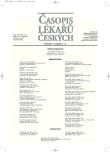Duodenal Atresia and Stenosis
Authors:
B. Rousková 1; J. Trachta 1; L. Kavalcová 1; P. Kuklová 1; M. Kynčl 2
Authors‘ workplace:
Klinika dětské chirurgie 2. LF UK a FNM a IPVZ, Praha
1; Klinika zobrazovacích metod 2. LF UK a FNM, Praha
2
Published in:
Čas. Lék. čes. 2008; 147: 521-526
Category:
Original Article
Overview
Background.
Analysis of results of surgical treatment of congenital duodenal obstruction at authors’ institution.
Methods and Results.
Retrospective analysis of demographic and clinical data collected from hospital and outpatient documentation. Age at operation, sex, type of duodenal obstruction, associated anomalies, type of operation, time of parenteral nutrition, onset of enteral nutrition, early and late complications were recorded and analyzed. Between January 1991 and December 2006, 77 patients (female to male ration 1.6 : 1) with duodenal obstruction were operated on. Among them there were 48 patients with duodenal atresia, 20 with duodenal membrane and 9 with annular pancreas. The average age at operation for duodenal atresia was 2.15 days, most patients (33 i.e. 43%) were operated on the 1st day of life. The average age at operation for duodenal membrane and annular pancreas was 7, 35 and 5, 8 days. In 33 patients diamond duodenoduodeno-anastomosis (Kimuraęs procedure) was performed, excision of membrane was the second most frequent operation (22 times). We noted complications in 38 patients, the most common one was sepsis (14 cases) followed by gastroesophageal reflux (6 times). The mortality in our group was 9,1% – 7 infants. One death only was caused by a surgical complication - anastomotic leakage. The period of follow-up was 5 months to 16 years.
Conclusions.
Congenital duodenal obstruction has, with appropriate surgical treatment, a good long and short-term prognosis. Ninety to 95% of patients survive without significant sequellae. The mortality is low and is caused by associated malformations, the principal cause of death is sepsis.
Key words:
duodenal atresia, congenital duodenal stenosis, duodenal membrane, annular pancreas, early enteral feeding.
Sources
1. Vacek, Z.: Embryologie pro pediatry. Praha, Vydavatelství J + P, 1992, s. 149–150.
2. Puri, P.: Newborn Surgery. Cambridge, Butterworth, Heinemann, 1996, s. 290–296.
3. Behrman, R. E., Kliegman, R. M., Jenson H. B.: Nelson Textbook of Pediatrics, 17th Edition. Philadelphia, Saunders, 2004, s. 1233–1234.
4. Rowe, M. I., O’Neil Jr, J. A., Grosfeld, J. L. et al.: Essentials of Pediatric Surgery. St. Louis, Mosby, 1995, s. 486–491.
5. Sing, M. V., Richards, C., Bowen, J. C.: Does Down syndrome affect the outcome of congenital duodenal obstruction? Pediatr. Surg. Int., 2004, 20, s. 586–589.
6. Escobar, M. A., Ladd, A. P., Grosfeld, J. L. et al.: Duodenal atresia and stenosis: Long - term follow-up over 30 years. J. Pediatr. Surg., 2004, 39, s. 867–871.
7. Sawicka, E., Boczar, M., Michalak, J. et al.: Congenital duodenal obstruction – part II. Med Wieku Rozwoj, 2004, s. 751–759.
8. Stinger, M. D., Mouriquand P. D. E, Oldham K. T., Howard E. R.: Pediatric surgery and urology: Long term outcomes. London, Philadelphia, Toroto, Sydney, Tokyo: W.B. Saunders Company Ltd., 1998, s. 272–273.
9. Šnajdauf, J., Škába, R.: Dětská chirurgie. Praha, Galén, Karolinum, 2005, s. 172–176.
10. Kimura, K., Tsugawa, C., Ogawa, K. et al.: Diamond – shaped anastomosis for congenital duodenal obstruction. Arch. Surg., 1977, 1121, s. 1262–1263.
11. Endo, M., Ukiyama, E., Yokoyama, J., Kitajima, M.: Subtotal duodenectomy with jejunal patch for megaduodenum secondary to congenital duodenal malformation. J. Pediatr. Surg., 1998, 33, s. 1636–1640.
12. Akhtar, J., Guiney, E. J.: Congenital duodenal obstruction. Br. J. Surg., 1992, 79, s. 133–135.
13. Jimenez, J. C., Emil, S., Podnos Y., Nguyen, N.: Annular pancreas in children: a recent decade’s experience. J. Pediatr. Surg., 2004, 39, s. 1654–1657.
14. Bax, N. M, Ure, B. M., van der Zee, D. C. et al.: Laparoscopic duodenostomy for duodena atresia. Surg. Endosc., 2001, 15, s. 217.
15. Suri, S., Eradi, B., Chowdhary, S. K. et al.: Early postoperative feeding and outcome in neonates. Nutrition, 2002, 18, s. 380–382.
16. Arnbjörnsson, E., Larsson, M., Finkel, Z. et al.: Transanastomotic feeding tube after an operation for duodena atresia. Eur. J. Pediatr. Surg., 2002, 12, s. 159–162.
17. Upadhyay, V., Sakalkale, R., Parashar, K. et al.: Duodenal atresia: a comparison of three modes of treatment. Eur. J. Pediatr. Surg., 1996, 6, s. 75–77.
Labels
Addictology Allergology and clinical immunology Angiology Audiology Clinical biochemistry Dermatology & STDs Paediatric gastroenterology Paediatric surgery Paediatric cardiology Paediatric neurology Paediatric ENT Paediatric psychiatry Paediatric rheumatology Diabetology Pharmacy Vascular surgery Pain management Dental HygienistArticle was published in
Journal of Czech Physicians

- Advances in the Treatment of Myasthenia Gravis on the Horizon
- Possibilities of Using Metamizole in the Treatment of Acute Primary Headaches
- Metamizole vs. Tramadol in Postoperative Analgesia
- Metamizole at a Glance and in Practice – Effective Non-Opioid Analgesic for All Ages
- What Effect Can Be Expected from Limosilactobacillus reuteri in Mucositis and Peri-Implantitis?
Most read in this issue
- Duodenal Atresia and Stenosis
- Pregnancy and Delivery in Type II Hereditary Antithrombin Deficient Patients
- Feedings of Critical Care Patients by Endoscopic Three-luminal Tube – A Retrospective Analysis
- Rare Diagnosis of CD4⁺56⁺ Leukemia from Dendritic Cells Type DC2
